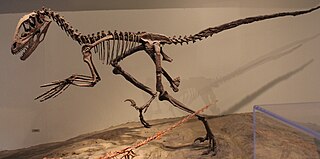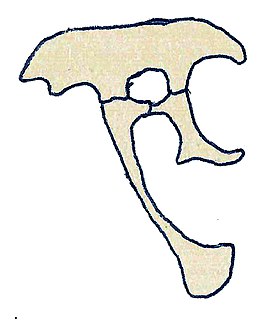
Velociraptor is a genus of dromaeosaurid theropod dinosaur that lived approximately 75 to 71 million years ago during the latter part of the Cretaceous Period. Two species are currently recognized, although others have been assigned in the past. The type species is V. mongoliensis; fossils of this species have been discovered in Mongolia. A second species, V. osmolskae, was named in 2008 for skull material from Inner Mongolia, China.

Deinonychus is a genus of carnivorous dromaeosaurid coelurosaurian theropod dinosaur with one described species, Deinonychus antirrhopus. This species, which could grow up to 3.4 metres (11 ft) long, lived during the early Cretaceous Period, about 115–108 million years ago. Fossils have been recovered from the U.S. states of Montana, Utah, Wyoming, and Oklahoma, in rocks of the Cloverly Formation, Cedar Mountain Formation and Antlers Formation, though teeth that may belong to Deinonychus have been found much farther east in Maryland.

Oviraptor is a genus of small Mongolian theropod dinosaurs, first discovered by technician George Olsen in an expedition led by Roy Chapman Andrews, and first described by Henry Fairfield Osborn, in 1924. Its name is Latin for 'egg taker' or "egg seizer", referring to the fact that the first fossil specimen was discovered atop a pile of what were thought to be Protoceratops eggs, and the specific name philoceratops means "lover of ceratopsians", also given as a result of this find. In his 1924 paper, Osborn explained that the name was given due to the close proximity of the skull of Oviraptor to the nest. However, Osborn also suggested that the name Oviraptor "may entirely mislead us as to its feeding habits and belie its character". In the 1990s, the discovery of nesting oviraptorids like Citipati proved that Osborn was correct in his caution regarding the name. These finds showed that the eggs in question probably belonged to Oviraptor itself, and that the specimen was actually brooding its eggs, when it died at the nest.

Protoceratops is a genus of sheep-sized herbivorous ceratopsian dinosaur, from the Upper Cretaceous Period of what is now Mongolia. It was a member of the Protoceratopsidae, a group of early horned dinosaurs. Unlike later ceratopsians, however, it was a much smaller creature that lacked well-developed horns and retained some primitive traits not seen in later genera.

Anserimimus( AN-sər-i-MY-məs; "goose mimic") is a genus of ornithomimid theropod dinosaur, from the Late Cretaceous Period of what is now Mongolia. It was a lanky, fast-running animal, possibly an omnivore. From what fossils are known, it probably closely resembled other ornithomimids, except for its more powerful forelimbs.

Oviraptorosaurs are a group of feathered maniraptoran dinosaurs from the Cretaceous Period of what are now Asia and North America. They are distinct for their characteristically short, beaked, parrot-like skulls, with or without bony crests atop the head. They ranged in size from Caudipteryx, which was the size of a turkey, to the 8 metre long, 1.4 ton Gigantoraptor. The group is close to the ancestry of birds. Analyses like those of Maryanska et al (2002) and Osmólska et al. (2004) suggest that they may represent primitive flightless birds. The most complete oviraptorosaur specimens have been found in Asia. The North American oviraptorosaur record is sparse.

Dromiceiomimus is a genus of ornithomimid theropod from the Late Cretaceous of Alberta, Canada.

Saurornithoides is a genus of troodontid maniraptoran dinosaur, which lived during the Late Cretaceous period. These creatures were predators, which could run fast on their hind legs and had excellent sight and hearing. The name is derived from the Greek stems saur~ (lizard), ornith~ (bird) and eides (form), referring to its bird-like skull.

Byronosaurus is a genus of troodontid dinosaur from the Late Cretaceous Period of Mongolia.

Adasaurus is a dromaeosaurid theropod dinosaur from the Late Cretaceous Period of Central Asia. It was a small bipedal carnivore with a sickle-shaped claw on the second toe of each hind foot, and was perhaps 1.8 m (5.9 ft) long. The genus name Adasaurus is taken from Ada, an evil spirit in the mythology of Mongolia, and the Greek word sauros meaning 'lizard'. The species name, for the single species,, refers to the country of origin. Adasaurus was named and described in 1983 by Mongolian paleontologist Rinchen Barsbold.
Unenlagia is a genus of theropod dinosaur from the Late Cretaceous of Argentina.

Citipati is a genus of oviraptorid theropod dinosaur from the Late Cretaceous Period of what is now Mongolia. It is one of the best-known oviraptorids, thanks to a number of well-preserved skeletons, including several specimens found in brooding positions atop nests of eggs. These nesting specimens have helped to solidify the link between non-avian dinosaurs and birds.

Shenzhousaurus is a genus of basal ornithomimosaur from the Lower Cretaceous of China.

Elmisaurus is an extinct genus of dinosaur from the Late Cretaceous. It was a theropod belonging to the Oviraptorosauria. Its fossils have been found in Mongolia. It is known from foot and hand bones.
The Djadochta Formation is a geological formation situated in central Asia, dating from the Late Cretaceous Period. Laid down in the early Campanian, possibly starting in the latest Santonian, it is dated somewhat uncertainly at about 75-71 mya. The type locality are the famous "Flaming Cliffs", locally known as Bayanzag or Ulaan-Ereg.

Halszka Osmólska was a Polish paleontologist who had specialized in Mongolian dinosaurs.
The Öösh Formation is a geological formation in Mongolia whose strata date back to the Early Cretaceous. Dinosaur remains are among the fossils that have been recovered from the formation.
Mark A. Norell is an American paleontologist and molecular geneticist, acknowledged as one of the most important living vertebrate paleontologists. He is currently the chairman of paleontology and a research associate at the American Museum of Natural History. He is best known as the discoverer of the first theropod embryo and for the description of feathered dinosaurs. Norell is credited with the naming of the genera Apsaravis, Byronosaurus, Citipati, Tsaagan, and Achillobator. His work regularly appears in major scientific journals and was listed by Time magazine as one of the ten most significant science stories of 1993, 1994 and 1996.

This timeline of troodontid research is a chronological listing of events in the history of paleontology focused on the troodontids, a group of bird-like theropod dinosaurs including animals like Troodon. Troodontid remains were among the first dinosaur fossils to be reported from North America after paleontologists began performing research on the continent, specifically the genus Troodon itself. Since the type specimen of this genus was only a tooth and Troodon teeth are unusually similar to those of the unrelated thick-headed pachycephalosaurs, Troodon and its relatives would be embroiled in taxonomic confusion for over a century. Troodon was finally recognized as distinct from the pachycephalosaurs by Phil Currie in 1987. By that time many other species now recognized as troodontid had been discovered but had been classified in the family Saurornithoididae. Since these families were the same but the Troodontidae named first, it carries scientific legitimacy.

This timeline of ornithomimosaur research is a chronological listing of events in the history of paleontology focused on the ornithomimosaurs, a group of bird-like theropods popularly known as the ostrich dinosaurs. Although fragmentary, probable, ornithomimosaur fossils had been described as far back as the 1860s, the first ornithomimosaur to be recognized as belonging to a new family distinct from other theropods was Ornithomimus velox, described by Othniel Charles Marsh in 1890. Thus the ornithomimid ornithomimosaurs were one of the first major Mesozoic theropod groups to be recognized in the fossil record. The description of a second ornithomimosaur genus did not happen until nearly 30 years later, when Henry Fairfield Osborn described Struthiomimus in 1917. Later in the 20th century, significant ornithomimosaur discoveries began occurring in Asia. The first was a bonebed of "Ornithomimus" asiaticus found at Iren Debasu. More Asian discoveries took place even later in the 20th century, including the disembodied arms of Deinocheirus mirificus and the new genus Gallimimus bullatus. The formal naming of the Ornithomimosauria itself was performed by Rinchen Barsbold in 1976.



















